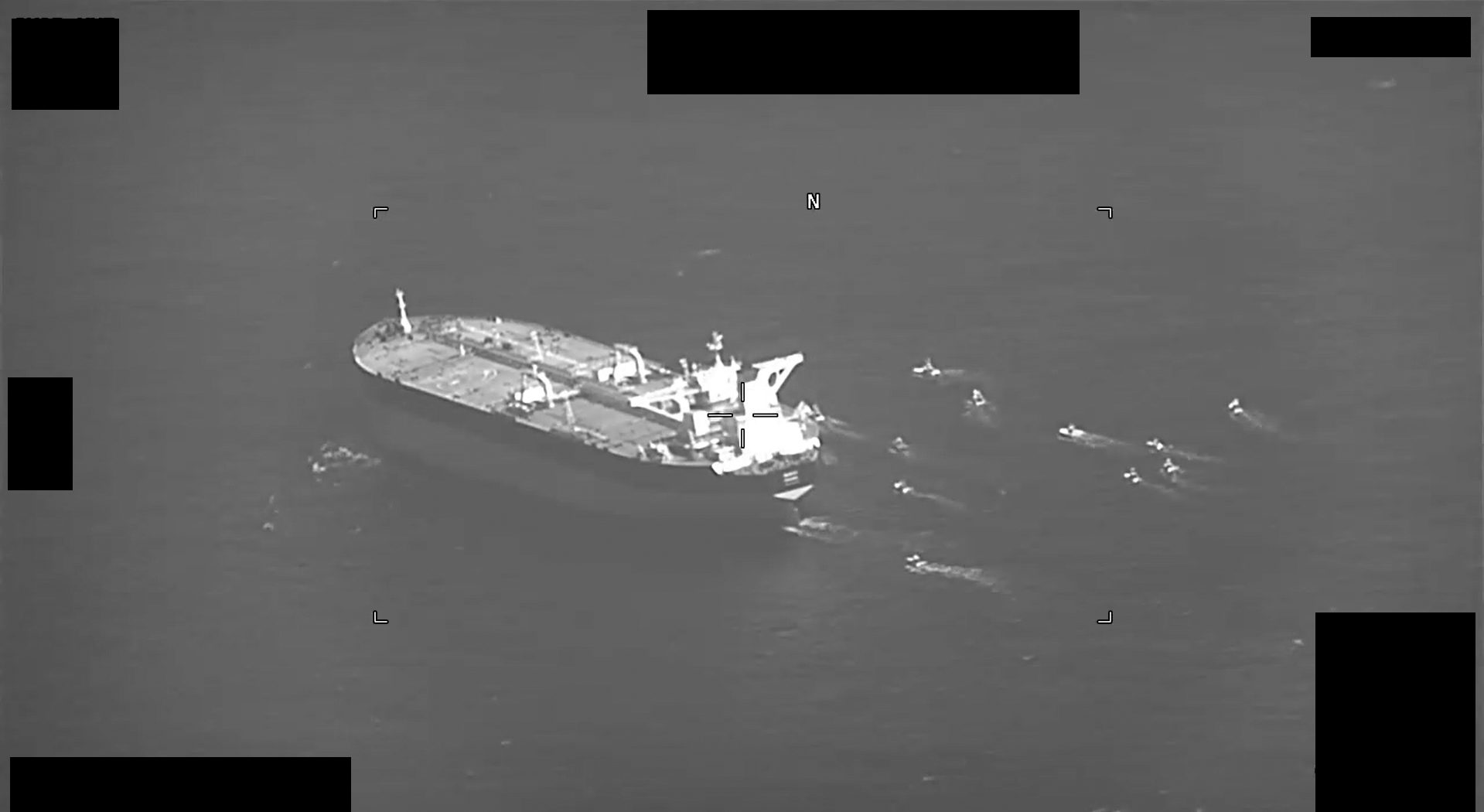Ships Fleeing The Red Sea Now Face Perilous African Weather
By Alex Longley and Paul Burkhardt (Bloomberg) –Ships sailing around the southern tip of Africa are wrestling with a bout of bad weather that has already run one vessel aground and...


A screenshot of a video showing fast-attack craft from Iran’s Islamic Revolutionary Guard Corps Navy swarming Panama-flagged oil tanker Niovi as it transited the Strait of Hormuz, May 3, 2023. U.S. Navy Photo
In response to escalating regional conflicts in the Middle East, the U.S. Maritime Administration has issued a new advisory to shipping that enhances previous guidelines for U.S.-flagged commercial ships navigating through high-risk areas including the Southern Red Sea, Bab el Mandeb Strait, and the Gulf of Aden, as well as the Strait of Hormuz and surrounding waters.
The comprehensive new guidance, which replaces a previous advisory, comes in response to the volatile maritime security situation in the region from a combination of Houthi attacks from Yemen, the resurgence of Somali piracy, and a aggressive actions by Iran that are affecting international shipping lanes critical to the global economy.
Despite efforts by the U.S. and its allies to safeguard these waters through operations like the U.S.-led Operation Prosperity Guardian and EU’s Operation Aspides in the Red Sea/Gulf of Aden, along with EU’s Operation Atalanta off the coast of Somalia, these efforts have so far been ineffective at ensuring the free flow of commerce in the region, particularly in regards to the Red Sea.
Notably, one of the new recommendations advises that vessels turn off their Automatic Identification System (AIS) transponders to reduce the risk of being targeted, especially in areas where the threat from Houthi forces is most significant.
Since November, the Houthi terrorist group has targeted dozens of ships with perceived affiliations with Israel, the U.S., and the UK in support of Palestinians “under siege” in Gaza. At times, these affiliations have been inaccurate.
In addition to threats from the Houthis and Somali piracy, the advisory also covers risks from Iranian forces in the Persian Gulf, Strait of Hormuz, Gulf of Oman, and Arabian Sea. Following former President Trump’s withdrawal of the United States from the Iran Nuclear Deal in 2018, Iran has attempted to illegally board and seize commercial vessels on more than 20 occasions.
MARAD’s advisory enumerates several incidents from the past year alone, including the April 2023 Iranian seizure of the Marshall Islands-flagged tanker, Suez Rajan, in the Gulf of Oman. This same vessel, renamed St. Nikolas, was seized again in the Arabian Sea in January 2024. Moreover, in May 2023, Iran seized the Panama-flagged tanker Niovi in the Strait of Hormuz. Iranian forces also tried unsuccessfully to seize the Marshall Islands-flagged tanker TRF Moss and the Bahamas-flagged tanker Richmond Voyager in the Gulf of Oman in July 2023, but were deterred by the response U.S. naval forces in the region.
“Iranian forces have utilized small boats and helicopters during boarding operations and have attempted to force commercial vessels into Iranian territorial waters,” the advisory states.
The MARAD advisory recommends that vessels affirm their adherence to international law if approached by Iranian forces and to remain as far from Iran’s territorial waters as possible without compromising navigational safety.
Piracy also continues to be a persistent threat to shipping, with recent incidents of boardings and hijackings in the Gulf of Aden, Arabian Sea, and Indian Ocean, including the hijackings of the commercial ships Ruen and Abdullah. The advisory recommends adherence to the Best Management Practices to Deter Piracy (BMP5) and consulting the Maritime Global Security website for pre-operation guidance.
The advisory also warns about unmanned aerial vehicles (UAVs) and limpet mines that pose a threat to commercial ships in areas including the Persian Gulf, Strait of Hormuz, Gulf of Oman, and Arabian Sea. Crewmembers are advised to relocate to a safe space on the vessel if a UAV is suspected. Limpet mines, which can be attached to vessel hulls, have been used to damage commercial ships in recent years.
Another significant development included in the advisory is the creation of the Red Sea/Gulf of Aden Joint Maritime Information Center (JMIC). The advisory describes this as a collective effort aimed at providing updated threat assessments and incident reports to improve response coordination.
The advisory emphasizes the importance of vigilance and the implementation of security measures onboard, including maintaining a proper lookout, preparing for emergency responses, and adhering to U.S. Coast Guard guidelines for operating in high-risk waters.
The updated guidance from the U.S. Maritime Administration underscores the evolving security challenges in these critical Middle East waterways and takes a comprehensive approach, learning from past incidents, to improve maritime safety in the region through international cooperation.
You can view the full advisory on the MARAD website here.
Join the gCaptain Club for curated content, insider opinions, and vibrant community discussions.


Join the 107,149 members that receive our newsletter.
Have a news tip? Let us know.
Access exclusive insights, engage in vibrant discussions, and gain perspectives from our CEO.
Sign Up




Maritime and offshore news trusted by our 107,149 members delivered daily straight to your inbox.



Essential news coupled with the finest maritime content sourced from across the globe.
Sign Up